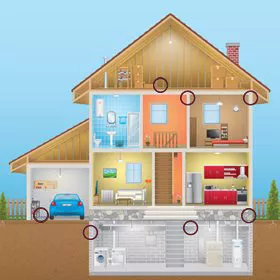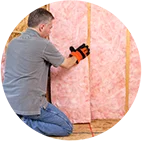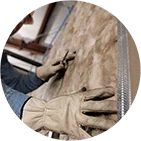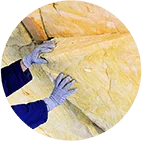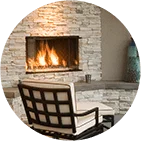Although the title of this post may make you think otherwise, we promise this won’t be like your boring tenth grade science class. Well, maybe a little—but understanding heat transfer on a basic level is important when it comes to insulation.
There are three methods of heat transfer: conduction, convection and radiation.
Conduction is the flow of heat or energy through solid materials, like wood framing or other building components. Insulating your home helps increase the R-value (resistance to heat flow) of these materials, making it much more difficult for heat to move to cooler areas (into air conditioned homes in the summer and cooler air outside in the winter).
- Best type of insulation: Fiberglass or cellulose installed in the walls
Convection is heat transfer through a gas or liquid. When you remove the lid from a pot of boiling water, the steam is a result of heat transfer by convection (and the water boils via convection). In your home, heat is lost through any gaps, leaks and cracks in the walls and around windows and doors. Unless the openings are properly sealed with insulation, hot air can flow into and out of your home, which can be costly and energy-inefficient.
- Best type of insulation: Spray foam installed in the walls
Radiant heat travels in waves or rays, like the heat we feel when standing too close to a fire. Your roof absorbs the radiant heat from the sun, causing your home to heat up very quickly. Proper insulation, like a radiant barrier, helps prevent that heat from entering the cooler living spaces of your home. Without something to block the heat absorbed by your attic through the roof, the rest of your home heats up as well. In fact, homes with radiant barrier insulation are up to 10 degrees cooler than homes without attic insulation (which makes a huge difference when it’s 90 degrees and sweltering outside)!
- Best type of insulation: radiant barrier installed in the attic
Insulation & Heat Transfer
Heat leaks into and escapes out of your house in a number of different ways:
- Walls
- Windows and doors
- Attic
- Ductwork
- Any crawl spaces
- Electrical outlets
- Recessed lights
- Dryer vents and bathroom fan vents
Different types of insulation also work in different ways. Insulation can absorb heat and trap it that way (such as fiberglass) and it can also reflect heat to keep your home cooler, which is how radiant barrier insulation works.
Have additional questions about insulation and heat transfer? Contact OJ Insulation today!


